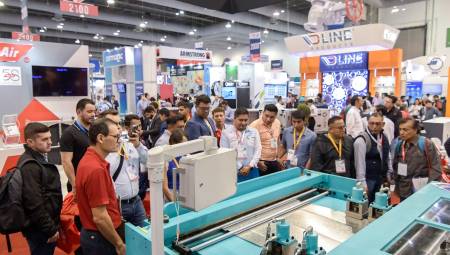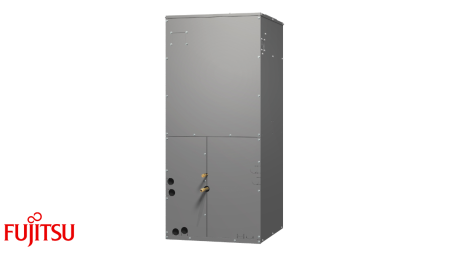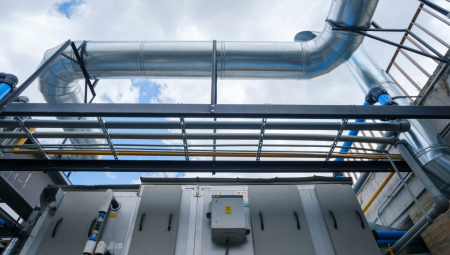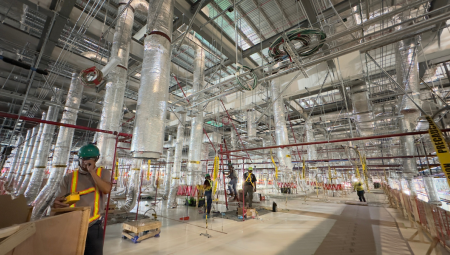 Advantages of using VRV systems*
Advantages of using VRV systems*
These systems were developed 30 years ago (1981) with the fusion of several cutting-edge technologies in mechanical engineering, electronics, computing and variable speed technology.
Some Variable Refrigerant Volume (VRV*) systems can offer simultaneous cold and heat in different evaporators connected to the same condenser.
These systems were developed 30 years ago (1981) with the fusion of several cutting-edge technologies in mechanical engineering, electronics, computing and variable speed technology. Let's start by defining the meaning of Variable Refrigerant Volume and the way it works. They are divided systems, of direct expansion, formed by a condenser and several evaporators (See figure 1).

Fig.1 Schematic of a VRV system
From the condenser, cooled by air, only two pipes come out: one for suction and one for refrigerant discharge. This pair of pipes is connected to all the evaporators in the system and is called Variable Refrigerant Volume (VRV), because the amount of refrigerant that circulates through the pipes to the evaporators varies according to the different needs of lowering load within the conditioned spaces to which the system is connected. The variation in refrigerant volume is achieved through the use of variable speed compressors, called inverter.
The speed of this compressor is determined by the pressure within the system. The compressor must maintain a constant pressure at all times; so, when the expansion valve of an evaporator opens, the pressure in the system drops and the compressor increases its speed to compensate for the low pressure within the system. Conversely, when the expansion valve of an evaporator closes, the pressure inside the system increases and the compressor slows down to decrease the pressure inside the system until it stabilizes.
The diameter of the pipes that interconnect evaporators and condenser varies and is selected according to the maximum amount of refrigerant that will pass through them. The number and capacity of evaporators that must be connected to a condenser depends on the capabilities of the same condenser and evaporators. A condenser (as shown in Figure 1) has three compressors: one inverter and two constant speed compressors.
VRV air conditioning systems can also be used by applying a "diversity of use". The recommendation of the manufacturers, depending on the application (hotel, office, etc.), is to connect up to 30% more capacity in evaporators, than the nominal capacity of the condenser.
A hypothetical example of the above would be that a condenser with a capacity of 10 kW of cooling can be connected evaporators that add up to a capacity of up to 13 kW of cooling. This diversity of use considers that not all spaces are used simultaneously and not all spaces require their maximum capacity synchronously. When all evaporators operate in unison, it will not be possible to obtain the maximum capacity from them.
It is normal in any direct expansion system for the oil to migrate into the evaporators or the pipes of the pulverized system along with the refrigerant when they operate. To recover the oil and prevent it from accumulating in the evaporators and/or pipes, regardless of the distance that may exist between the condenser and its evaporators, VRV systems are programmed in such a way that, after certain hours in operation, the system makes an oil sweep on all evaporators (including those that are turned off).
When this happens, no matter what capacity the system is working at, constant-speed compressors are turned on; variable speed compressors adjust their speed depending on whether the system works in cold mode or heating mode, and the expansion valves of all evaporators connected to that condenser open to allow oil found in pipes and evaporators to return to the condenser. The system remains in that state for a few minutes. After this process, the system returns to operation with the parameters it had before starting the oil recovery.
VRV systems have a sophisticated electronic control system, individualized comfort in each zone, heat recovery from one zone to another, so some of these systems can offer simultaneous cold and heat in different evaporators connected to the same condenser. These functions are also available in water-cooled condensers. The amount of refrigerant to be charged to the VRV system is calculated based on the characteristics of the system (diameter and distance of the pipes to interconnect evaporators, plus the refrigerant contained in the factory condensers).
Once such systems are installed, they are tested under pressure and vacuum. Later, the additional refrigerant charge carried by the system is carried out and the valves in the condenser are opened to release the refrigerant they contain. It is difficult for refrigeration systems to leak the refrigerant supplied to them after the above procedures; however, there is a chance that it will happen. For this reason, it is important that designers consider the necessary security measures in case of such an eventuality.
The refrigerant used in current VRV systems is R410A, which is not harmful to the ozone layer. This refrigerant is a 50-50% mixture of R32 and R125; for this reason, it must be charged to the system in a liquid state to ensure its composition and that the cooling system works properly.
Electrically, in Mexico, these systems are offered at 220V or 460V, 3Ø, 60Hz, to power the capacitors; for small capacitors, they are offered at 220VAC, 1Ø, 60Hz. Without considering the above and in another electrical circuit, the evaporators are fed with 220V, 1Ø, 60Hz.

Fig.2 Electrical and control diagram of a VRV system
Each of the electrical circuits mentioned must have a service switch. The only connection between condenser and evaporators is the communication system (red dashed line in Figure 2), which is made with a 18AWG gauge twisted pair. It leaves the condenser and passes through each of the evaporators in the system until it reaches the last of them.
Each of the evaporators can be connected to a quarter wired controller (as shown in Figure 2). A variant of the above is that a single room controller is connected to two or more evaporators so that they work simultaneously. There are also evaporators that are manipulated by wireless controls.
The copper pipe recommended to make the interconnections of these systems must be free of dust and impurities, and have wall thickness that resists a pressure of 3.8MPa. Commercially, the type of pipe that meets these characteristics is the "cooling type" pipe, which comes clean and sealed.
*VRV is a registered trademark of DAIKIN












